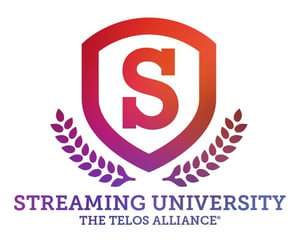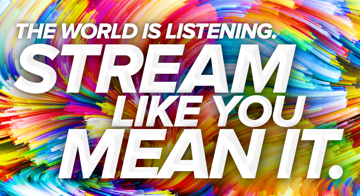Streaming University: The Complete Broadcast Streaming Audio Resource | Telos Alliance
By The Telos Alliance Team on Oct 26, 2016 12:55:00 PM
 Streaming University: The Complete Broadcast Streaming Audio Resource
Streaming University: The Complete Broadcast Streaming Audio Resource
These days, streaming audio is everywhere, and the importance of streaming continues to grow for broadcasters across the globe. Anymore, simply having an audio stream isn’t enough - though it’s a start if you’re not already streaming now. If you aren’t, you don’t want to miss out on this opportunity to maximize listenership - and revenues! Broadcast streaming audio has become such an important facet of many radio stations’ offerings that it’s making up a larger portion of broadcast revenues every year.
Because this essential technology continues to proliferate, there’s a lot to know - even for those who have been streaming for several years. That’s why, earlier this year, the Telos Alliance developed Streaming University, a series of classes and an accompanying YouTube video series providing everything you need to know about streaming audio.
Kirk Harnack, host of the Streaming University video series, explains that this important resource was set up to allow broadcasters the option to watch only the videos covering what they need to know whenever it’s convenient for them, based on where they are with their streaming operation, or what topics they might require more information on.
“We divided Streaming University into 14 chapters so people who need to know the information there can pick and choose where they need to go,” says Kirk. “It’s not an hour-and-a-half webinar that you have to absorb all in one chunk. If you already know any one of these topics, you can skip those chapters, but if you need to know a specific topic a little better, you can watch that particular chapter only.”
This is a key aspect of Streaming University - the content covers a range of topics for everyone from those just getting started with streaming to those who have been streaming for years. There are still many broadcasters who aren’t streaming, while others are using advanced processing and encoding gear to provide the best possible audio for their streams.
Covering the Basics
Kirk notes that for those stations that are not yet streaming, right now is the perfect time to start. “It’s never been easier to get high quality audio out of your automation system or intercept the audio that is otherwise bound for your station’s on-air processor, and feed that audio into a PC running streaming software, or a hardware appliance dedicated to streaming audio.”
While a little over half of all U.S. radio stations are streaming, how good those streams sound, how easy they are to find, and what the listener experience is can be quite variable from one station to another. “This is where the challenge comes in for stations that are already streaming,” Kirk says. “The key question that station owners, managers, programmers, and engineers need to ask themselves is ‘How good is it?’ You may be streaming online, but what does it sound like compared to your competitors? With modern audio processing equipment, and using a modern audio codec, even at reasonable bit rates, a radio station’s stream should sound as good as their over-the-air experience… Sometimes even better.”
"The key question that station owners, managers, programmers, and engineers need to ask themselves is ‘How good is it?’"
—Kirk Harnack
Once an audio stream is up and running, a radio station can distribute their streams themselves, or contract with a content distribution network (CDN) to distribute their audio, the cost of which is typically well under $100 per month. For many small to medium market stations, this is about all it takes to make your streams available to as many people as you might expect to listen. Broadcasters can then publish the link to the audio stream that the CDN provides to their radio station’s website, as well as on various listing services that will list your station as broadcasting on the internet.
Streaming Audio = Revenue Stream
One reason streaming audio is so important is revenue. The predictions are that by 2020, man y radio stations will be getting about 25-27% of their revenue from streaming. However the model that works best for generating revenue through streaming audio isn’t quite clear yet.
y radio stations will be getting about 25-27% of their revenue from streaming. However the model that works best for generating revenue through streaming audio isn’t quite clear yet.
Several options exist. For example, some stations do an add-on to their over-the-air advertising and include spots on the stream, while other stations increase their overall spot rates because everything gets included. Still other radio stations sell banner ads on a streaming app, while a handful of other stations have developed additional streams—audio channels that they can’t do over the air—often for niche programming such as high school sports, local government news, or local arts programming. This way, they’re able to sell this extra content to generate additional streaming revenues. Some stations use a mix of these methods to see what works best for them in an effort to maximize revenues from streaming.
“Radio stations have the technology, they have the name recognition, and they have the sales staff," Kirk points out. "They have all these key ingredients to make non-traditional revenue through streaming audio.”
Positive Feedback
There’s a lot to know when it comes to streaming, and these concerns are just some of the topics covered by Streaming University. “It’s nearly impossible for any one engineer or broadcaster to know all there is to know about internet streaming,” Kirk emphasizes. “The good news is, you can learn it in bite-size pieces, from beginning to end. Not only what it takes technically, what some of the best practices are, and what the legal ramifications are such as licensing, but also some important - if a bit opinionated - advice with regard to how to right size your streaming operation so you can get the maximum bang for your buck from your Content Distribution Network.”
And the response to Streaming University? “The feedback we’re getting is just terrific. The engineers, program directors, and station owners are telling me they absolutely love this resource—that it has opened their eyes—not only to all of the facets of streaming and little bits of complexity that exist, but it has helped them to make it as simple as can be, so they can be on the internet, streaming worldwide. People have contacted me thanking Telos for making Streaming University available. It’s that helpful, and it’s that meaningful to broadcasters.”
Doing streaming right
 The Telos Alliance uses the slogan “Stream like you mean it.” The idea behind this is that the approach should be no different for streaming audio than it is for a terrestrial broadcast signal. “Broadcasters tend to buy the best audio processor they can afford,” Kirk insists. “They try to get a reliable transmitter, and a reliable studio-to-transmitter link. Why? Because they need to serve their communities in such a way that they sound great and their stations are reliable. The public expects that.”
The Telos Alliance uses the slogan “Stream like you mean it.” The idea behind this is that the approach should be no different for streaming audio than it is for a terrestrial broadcast signal. “Broadcasters tend to buy the best audio processor they can afford,” Kirk insists. “They try to get a reliable transmitter, and a reliable studio-to-transmitter link. Why? Because they need to serve their communities in such a way that they sound great and their stations are reliable. The public expects that.”
So why not treat your audio stream the same way?
“The public expects the same thing from an internet stream; it needs to sound great, and it needs to be reliable. The good news is, with streaming, the cost to do it right is far less than the cost of traditional over-the-air transmission, so it’s essential to use the right gear. Then—and only then—will you be streaming like you mean it.”
Further Reading
For additional insight into Streaming Audio, check out these blog posts:
Are you (adaptive) streaming like you mean it?
All About Adaptive Audio Streaming
Hardware Versus Software Streaming: Which Is Right for Your Facility?
The Stream Locomotive is leaving the station. Don't get left behind.
Adaptive Streaming Details with Ioan Rus
Adaptive Streaming with Tim Pozar
Deja Vu All Over Again: Paralleling Streaming with the Growth of FM
Telos Alliance has led the audio industry’s innovation in Broadcast Audio, Digital Mixing & Mastering, Audio Processors & Compression, Broadcast Mixing Consoles, Audio Interfaces, AoIP & VoIP for over three decades. The Telos Alliance family of products include Telos® Systems, Omnia® Audio, Axia® Audio, Linear Acoustic®, 25-Seven® Systems, Minnetonka™ Audio and Jünger Audio. Covering all ranges of Audio Applications for Radio & Television from Telos Infinity IP Intercom Systems, Jünger Audio AIXpressor Audio Processor, Omnia 11 Radio Processors, Axia Networked Quasar Broadcast Mixing Consoles and Linear Acoustic AMS Audio Quality Loudness Monitoring and 25-Seven TVC-15 Watermark Analyzer & Monitor. Telos Alliance offers audio solutions for any and every Radio, Television, Live Events, Podcast & Live Streaming Studio With Telos Alliance “Broadcast Without Limits.”
More Topics: Streaming Audio, adaptive streaming, audio, streaming, broadcast streaming, streaming for radio
Recent Posts
Subscribe
If you love broadcast audio, you'll love Telos Alliance's newsletter. Get it delivered to your inbox by subscribing below!